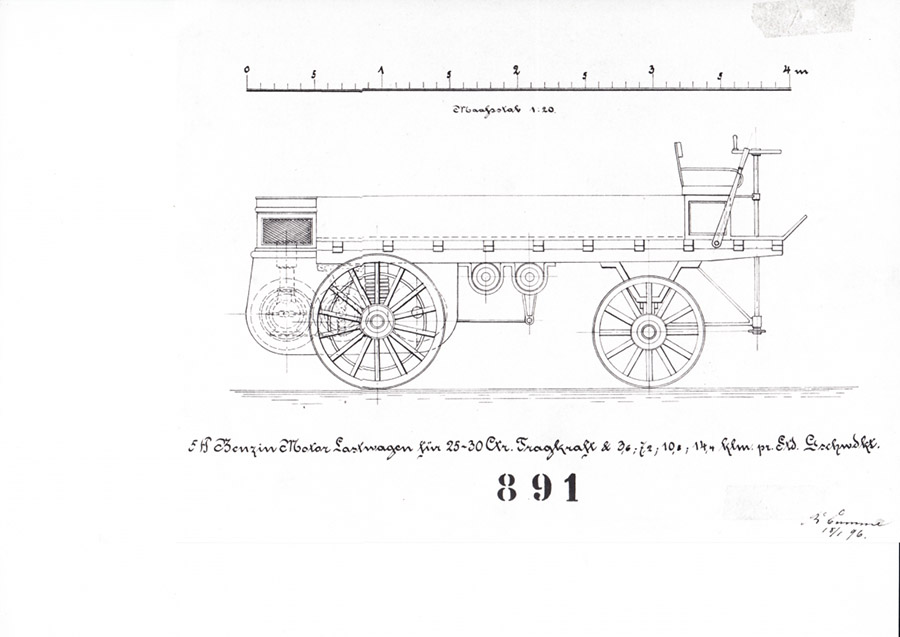The Evolution of Trucks Over Time
Trucks, as we know them today, are an essential part of modern transport and logistics. However, their history begins long before they became the giants of the road. Since their invention, these vehicles have undergone an impressive evolution, adapting to the needs of each era.
The First Engines: 19th Century
The origins of the truck date back to the end of the 19th century, at the height of the industrial revolution. In 1896, Gottlieb Daimler presented the first vehicle that could be considered a truck, powered by an internal combustion engine. This primitive truck had a limited load capacity, but it was a milestone in the mechanization of transport.
Steam engines were also a key player in this early stage. However, their lack of efficiency and the complexity of their operation quickly made them obsolete compared to combustion engines.
Schemazeichnung Daimler-Lkw von 1896//Scheme drawing of a Daimler truck from 1896
The First Combustion Trucks: Early 20th Century
At the beginning of the 20th century, gasoline-powered trucks began to take over. Diesel engines, introduced in the 1920s, revolutionized the sector, providing greater power and efficiency. Companies such as Ford, with its famous Model TT in 1917, marked the beginning of mass production of trucks, facilitating the transport of goods on a large scale.
Trucks during World War II
During World War II, trucks played a crucial role in military operations. They became a vital logistical resource, transporting troops, food, and supplies. During this period, the demand for more robust and rugged trucks drove significant technological advances. Military vehicles influenced the design of commercial trucks in the following decades, especially in terms of durability and load capacity.
The Expansion of Commercial Transport: 1950-1970
With the end of the war, global economic growth increased the demand for commercial transport. Trucks became the mainstay of modern supply chains, in many cases displacing trains as the primary means of ground transportation. During this time, truck capacity increased significantly, and advances in aerodynamics and materials allowed for the development of more efficient vehicles.
Innovation and Sustainability: From the 80s to the Present
Over the past few decades, technology has transformed the design and operation of trucks. In the 1980s and 1990s, manufacturers began focusing on safety and fuel efficiency, introducing technologies such as ABS brakes and aerodynamic improvements.
Today, the industry is seeing a shift towards sustainability. With growing concerns about the environmental impact of transportation, electric and hydrogen trucks are emerging as viable alternatives. Tesla, Nikola, and other companies are developing electric trucks that promise to revolutionize freight transportation in the coming years, reducing emissions and operating costs.
The Future of Trucks
The future of trucking is shaped by automation and sustainability. Autonomous trucks, though still in development, promise to increase efficiency and safety on the roads. Companies like Waymo and Uber are testing self-driving trucks that could transform global logistics.
Electrification will also be key, with the massive implementation of electric and hydrogen trucks, which will reduce the carbon footprint of the transport industry.
Trucks have come a long way from their steam-powered beginnings to the era of electrification and autonomous vehicles. As technology advances, efficiency and sustainability become the primary focus of freight transportation. For those who rely on reliable performance from their diesel engines, having quality replacement parts is essential.
At Motores Colombia , we specialize in the marketing and import of diesel engines and spare parts to ensure that your trucks are always in optimal condition. Trust us to keep your fleet running at maximum efficiency. Visit our store and find out how we can help you keep your business moving!



Comments